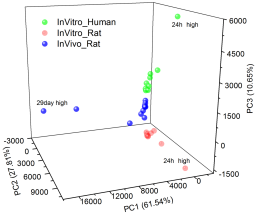In vitro to in vivo extrapolation for drug-induced liver injury using a pair ranking method
Main Article Content
Abstract
Preclinical animal toxicity studies may not accurately predict human toxicity. In light of this, in vitro systems have been developed that have the potential to supplement or even replace animal use. We examined in vitro to in vivo extrapolation (IVIVE) of gene expression data obtained from The Open Japanese Toxicogenomics Project-Genomics Assisted Toxicity Evaluation System (Open TG-GATEs) for 131 compounds given to rats for 28 days, and to human or rat hepatocytes for 24 hours. Notably, a pair ranking (PRank) method was developed to assess IVIVE potential with a PRank score based on the preservation of the order of similarity rankings of compound pairs between the platforms using a receiver operating characteristic (ROC) curve analysis to measure area under the curve (AUC). A high IVIVE potential was noted for rat primary hepatocytes when compared to rat 28-day studies (PRank score = 0.71) whereas the IVIVE potential for human primary hepatocytes compared to rat 28-day studies was lower (PRank score = 0.58), indicating that species difference plays a critical role in IVIVE. When limiting the analysis to only those drugs causing drug-induced liver injury, the IVIVE potential was slightly improved both for rats (from 0.71 to 0.76) and for humans (from 0.58 to 0.62). Similarly, PRank scores were improved when the analysis focused on specific hepatotoxic endpoints such as hepatocellular injury, or cholestatic injury. In conclusion, toxicogenomic data generated in vitro yields a ranking of drugs regarding their potential to cause toxicity which is comparable to that generated by in vivo analyses.
Article Details
Articles are distributed under the terms of the Creative Commons Attribution 4.0 International license (http://creativecommons.org/licenses/by/4.0/), which permits unrestricted use, distribution and reproduction in any medium, provided the original work is appropriately cited (CC-BY). Copyright on any article in ALTEX is retained by the author(s).


